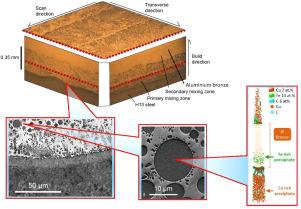多材料增材制造中铝青铜在H13钢组织上的定向能沉积
IF 5.5
2区 材料科学
Q1 MATERIALS SCIENCE, CHARACTERIZATION & TESTING
引用次数: 0
摘要
多年来,多材料增材制造越来越受到人们的关注,因为可以结合不同合金的属性来制造具有定制性能的零件。本研究采用粉末原料激光定向能沉积的方法,研究了铝青铜与AISI H13工具钢的结合,重点研究了结合界面附近的微观组织。结合这些材料可以利用青铜的热性能和工具钢的机械性能。表征是使用多种技术进行的,包括光学和二次电子显微镜,原子探针断层扫描和x射线显微断层扫描。青铜在钢上的沉积导致了钢和青铜之间几乎没有缺陷的界面,以及一个混合区,其中几乎球形的富铁颗粒悬浮在青铜基体中。铁铜液中的混相间隙主要是导致这些球状富铁颗粒形成的原因,而液相中元素的分离被认为是阻止金属间颗粒形成的原因。此外,混合区周围区域的硬度增加,在铜-钢界面上下约1mm,与大块青铜和钢相比。本文章由计算机程序翻译,如有差异,请以英文原文为准。

Directed energy deposition of aluminium bronze onto H13 steel-microstructure in multi-material additive manufacturing
Multi-material additive manufacturing has over the years had increasing interest due to the possibility of combining attributes of different alloys to create parts with tailored properties. This study investigates the combination of aluminium bronze and AISI H13 tool steel, through laser-based directed energy deposition with powder feedstock and focuses on the microstructure near the bonding interface. Combining such materials can utilize the thermal properties of bronze and the mechanical properties of tool steel. The characterization was performed using a variety of techniques, including optical– and secondary electron microscopy, atom probe tomography, and X-ray microtomography. The deposition of bronze onto steel resulted in an interface nearly free of imperfections between steel and bronze, as well as a mixing zone where nearly spherical iron-rich particles were suspended in a bronze matrix. The miscibility gap in the iron-copper liquid primarily caused the formation of these spherical iron-rich particles, and the separation of elements in the liquid phase is believed to prevent the formation of intermetallic particles. Additionally, the region around the mixing zone exhibited increased hardness, approximately 1 mm above and below the bronze-steel interface, compared to the bulk bronze and steel.
求助全文
通过发布文献求助,成功后即可免费获取论文全文。
去求助
来源期刊

Materials Characterization
工程技术-材料科学:表征与测试
CiteScore
7.60
自引率
8.50%
发文量
746
审稿时长
36 days
期刊介绍:
Materials Characterization features original articles and state-of-the-art reviews on theoretical and practical aspects of the structure and behaviour of materials.
The Journal focuses on all characterization techniques, including all forms of microscopy (light, electron, acoustic, etc.,) and analysis (especially microanalysis and surface analytical techniques). Developments in both this wide range of techniques and their application to the quantification of the microstructure of materials are essential facets of the Journal.
The Journal provides the Materials Scientist/Engineer with up-to-date information on many types of materials with an underlying theme of explaining the behavior of materials using novel approaches. Materials covered by the journal include:
Metals & Alloys
Ceramics
Nanomaterials
Biomedical materials
Optical materials
Composites
Natural Materials.
 求助内容:
求助内容: 应助结果提醒方式:
应助结果提醒方式:


